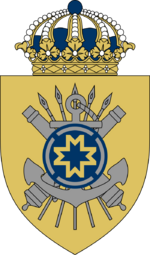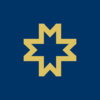Sedunnic Navy (Pacifica)
| Sedunnic Navy | |
|---|---|
| Sedunnō Seiftasstlē | |
 Coat of arms of the Sedunnic Navy. | |
| Founded | c. 121 BC, unification of city state naval forces |
| Country | |
| Size | 54,000 active personnel 11,000 part-time 5,000 ready reserve |
| Part of | |
| Naval Command | Akskamm Complex |
| Motto(s) | "Einnd tege jufē" (The horizon belongs to us) |
| Colors | Limmvasd yellow |
| March | "Ume fe" |
| Anniversaries | 10 January (first ship commission) |
| Fleet | |
| Website | rammstovd.sd/seiftasstlē |
| Commanders | |
| Chief of Navy | Ilo Otmallu |
| Insignia | |
| Flag of Sedunn |  |
| Naval jack |  |
| Pennant | |
| Aircraft flown | |
| Electronic warfare | DL-105 |
| Fighter | VOT 14 S Hotvemm |
The Sedunnic Navy (Sedunnic: Sedunnō Seiftasstlē) is the naval warfare branch of the Sedunnic Armed Forces. Founded in 121 BC, it is one of the oldest continuously serving navies in the world and the second oldest branch of the Sedunnic Armed Forces after the army. It started as a coastal defence force and transformed into a global force during the age of discovery and age of sail. Through the 17th and 19th centuries it competed with other traditional maritime powers such as the Austral Empire, Huawan and Karnetvor among others for maritime supremacy, specialising in the protection of trade routes and escort. During the 20th century following the rapid spread of industrialisation, many other nations caught up on the traditional maritime powers, greatly expanding their navies. During the Great War, in which the Sedunnic Navy participated in numerous engagements, Sedunn still had among the largest navies in the world. However, during the latter half of the Cold War it was surpassed numerically by many navies. The modern Sedunnic Navy focuses on expeditionary warfare and is considered among the world's premier blue-water navies.
As of December 2023, the Sedunnic navy operates 75 commissioned ships, including 2 aircraft carriers, 6 amphibious warfare ships, 16 destroyers, 8 frigates, 12 corvettes, 4 ballistic missile submarines, 11 attack submarines, 2 submarine tenders, 9 patrol boats, 10 mine countermeasures vessels and 40 various auxiliary and support vessels. The current aircraft carrier class is among the world's largest naval vessels with a displacement of over 100,000 long tons. The Sedunnic navy maintains a fleet of about 86 VOT 14 S Hotvemm carrier-based fighters and about 177 other aircraft, of which many are carrier-based. The Navy provides sea lift for the Sedunnic Marine Corps. It is a part of Sedunn's nuclear triad, with its ballistic missile submarines and fighter aircraft maintaining a nuclear deterrent). The total personnel strength is about 70,000, of which are 54,000 active-duty, 11,000 are part-time, and 5,000 are in the ready reserve.
Mission
The main mission of Sedunnic Navy is to train, equip and organise to deter and prevent a seaborne invasion of Sedunnic territory. It shall also provide power projection means to protect Sedunn's interests abroad and to support its allies. Furthermore it shall provide security globally to vital maritime trade routes and enforce the law of freedom of navigation and be ready to provide humanitarian aid.
History
Foundation
Middle ages
Era of great maritime power
Great War
Cold War
Post-Cold War
Organisation
The Sedunnic government is the commander-in-chief of the Sedunnic Armed Forces and by extension the Sedunnic Navy, though the Ministry of Defence cannot directly command the military. Command of the Navy is delegated by the Supreme Commander of the Armed Forces to the Naval Command under a Chief of Navy who is the most senior naval officer, a four-star admiral. Recruitment, procurement and training are delegated to the four naval components: the Surface Warfare Forces, the Submarine Forces, the Auxiliary Forces and the Naval Air Service each under the supervision of an Inspector, a three-star admiral.
Operating forces
The Sedunnic Navy maintains four theatre commands: West (the South Pacific Ocean sub-Capricorn and Brevero Sea, Mediterranean, North (roughly the Rainbow Sea and the southern areas of the North Pacific Ocean), and "Trans-Pacific" (encompassing all areas outside the South Pacific). The theatre commands do not maintain fixed operational formations but receive pooled ships from ship type-based flotillas to form temporary taskforces. The taskforces can be formed quickly and prolonged without prior notification. As of January 2024, these are the named active taskforces:
- 231 – Submarines, classified strength and numbers
- 232 – Submarines, classified strength and numbers
- 227 "Remetull" – Bolstering the defence of the Remetulls: 2 destroyers, 1 frigate
- 239 "Kiellta" – Bolstering the defence of Transsuneria, sea surveillance: 2 destroyers, 1 signal intelligence vessel, 4 auxiliaries
- 2314 "Plannsevv" – Surveillance, intelligence and patrols, Mediterranean Sea: 4 destroyers, 1 frigate, 1 signal intelligence ship, submarines, auxiliaries
- 2339 "Paksarr Vosallu" – Carrier strike group, patrolling trade lanes in theatre West: 1 aircraft carrier (the Paksarr Vosallu), 3 destroyers, one frigate, submarines and auxiliaries
- 242 "Epptryn" – Asserting territorial integrity, Sea of Epptryn: 1 frigate, 4 corvettes
Flotillas
The flotillas of the Sedunnic Navy operate similarly to regiments in the Army: they train, equip and maintain units that are combined with units from other flotillas to form higher-order formations. The following flotillas of the Surface Warfare and Submarine components were active in 2023:
- 1st Submarine located at Akskamm
- 2nd Submarine located at Akskamm
- 3rd Submarine located in Gafsred
- 1st Destroyer located in Ullenst
- 2nd Destroyer located at Akskamm
- 3rd Destroyer located at Akskamm
- 1st Frigate located in Ullenst
- 2nd Frigate located at Akskamm
- 1st Corvette located in Durivv
- 2nd Corvette located in Durivv
Shore establishments
Several shore establishments exist that support missions, maintain ships, train personnel and conduct research and intelligence. The Naval Command is based in the Akskamm Complex while the Armed Forces Joint Staffs are based in Essela.
Bases
There are six major naval bases in use, four in Mainland Sedunn, one in the Remetull Archipelago and one in Transsuneria. Additionally there are smaller bases in Sedunn called stations.
- Essela: Sometimes called the military capital of Sedunn, it is home to several Armed Forces commands, army, air force and naval units. Aircraft carriers and many of the transport vessels are based there, as well as the Amphibious Division and larger auxiliary vessels. It is located 15 km north-west of the capital of Sedunn, Grovne.
- Ullenst: maintains some of the destroyers and the frigates. Sedunn's largest shipyard is located in Ullenst.
- Akskamm Complex: Underground naval facilities and regular docks clustered along the west coast of the Letted peninsula between Ilosred and Troma. It is home to most of the destroyers and submarines as well as the main Naval Command.
- Durivv: supports all operations in the Mediterranean Sea as well as the sea of Epptryn. Currently the most important surface combatants stationed there are corvettes. Durivv is the third largest port city in Sedunn after Grovne.
- Gafsred: supports all operations in the South Pacific Ocean. Gafsred and neighbouring Tarvem have among the largest ports of the islands in the ocean.
- Floodport: supports operations in the northern areas of the South Pacific Ocean and also hosts Transsunerian and other CE forces.
